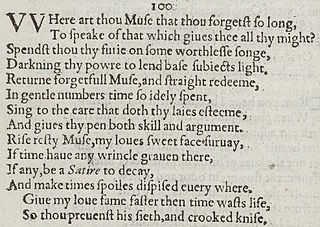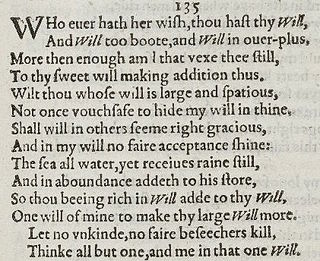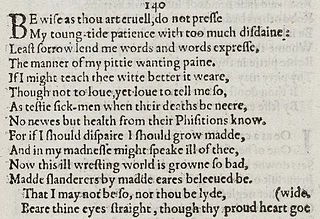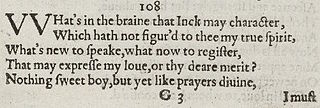| Sonnet 153 | |||||||
|---|---|---|---|---|---|---|---|
 Sonnet 153 in the 1609 Quarto | |||||||
| | |||||||
| |||||||
Sonnet 153 is a sonnet by William Shakespeare.
| Sonnet 153 | |||||||
|---|---|---|---|---|---|---|---|
 Sonnet 153 in the 1609 Quarto | |||||||
| | |||||||
| |||||||
Sonnet 153 is a sonnet by William Shakespeare.
Sonnets 153 and 154 are filled with rather bawdy double entendres of sex followed by contraction of a venereal disease. [2] The sonnet is a story of Cupid, who lays down his torch and falls asleep, only to have it stolen by Diana, who extinguishes it in a "cold valley-fountain." The fountain then acquires an eternal heat as a result and becomes a hot spring where men still come to be cured of diseases. The speaker then states that as his mistress looks at him, Cupid's torch is ignited again, and Cupid tests the torch by trying it on the speaker's heart. The speaker becomes sick with love and wants to bathe in the hot spring to cure himself, but he cannot. The speaker discovers the only thing that can cure his discomfort is a glance from his mistress.
Sonnet 153 is an English or Shakespearean sonnet. The English sonnet has three quatrains, followed by a final rhyming couplet. It follows the typical rhyme scheme of the form ABAB CDCD EFEF GG and is composed in iambic pentameter, a type of poetic metre based on five pairs of metrically weak/strong syllabic positions. The 12th line exemplifies a regular iambic pentameter:
× / × / × / × / × / And thither hied, a sad distemper'd guest, (153.12)
The 1st line begins with a common metrical variation, an initial reversal:
/ × × / × / × / × / Cupid laid by his brand and fell asleep: (153.1)
Line 9 potentially incorporates an initial reversal, and line 6 has a mid-line reversal. The 3rd line features the rightward movement of the first ictus (resulting in a four-position figure, × × / /, sometimes referred to as a minor ionic):
× × / / × / × / × / And his love-kindling fire did quickly steep (153.3)
A minor ionic also occurs in line 4.
The meter demands that line 10's "trial" be pronounced as two syllables. [3]
Sonnets 153 and 154 are anacreontics, [4] a literary mode dealing with the topics of love, wine, and song, and often associated with youthful hedonism and a sense of carpe diem, in imitation of the Greek poet Anacreon and his epigones. [5] The two anacreontic sonnets are also most likely an homage to Edmund Spenser. Spenser's Amoretti and Epithalamion has a three-part structure: a sonnet sequence of 89 sonnets, a small series of anacreontic verses and a longer epithalamium. Shakespeare imitates Spenser with a sequence of 152 sonnets, two anacreontic sonnets and a long complaint. [6]
The central conceit of Sonnet 153 derives from a work by Marianus Scholasticus, a poet writing in Greek in the 5th-6th centuries AD. The original epigram reads in translation "Beneath these plane trees, detained by gentle slumber, Love slept, having put his torch in the care of the Nymphs; but the Nymphs said to one another 'Why wait? Would that together with this we could quench the fire in the hearts of men.' But the torch set fire even to the water, and with hot water thenceforth the Love-Nymphs fill the bath." [7]

As the last in the famed collection of sonnets written by English poet and playwright William Shakespeare from 1592 to 1598, Sonnet 154 is most often thought of in a pair with the previous sonnet, number 153. As A. L. Rowse states in Shakespeare's Sonnets: The Problems Solved, Sonnets 153 and 154 "are not unsuitably placed as a kind of coda to the Dark Lady Sonnets, to which they relate." Rowse calls attention to the fact that Sonnets 153 and 154 "serve quite well to round off the affair Shakespeare had with Emilia, the woman characterized as the Dark Lady, and the section of the Dark Lady sonnets". Shakespeare used Greek mythology to address love and despair in relationships. The material in Sonnets 153 and 154 has been shown to relate to the six-line epigram ascribed to Marianus Scholasticus in the Greek Anthology. The epigram resembles Sonnets 153 and 154, addressing love and the story of Cupid, the torch, and the Nymph's attempt to extinguish the torch.

Sonnet 100 is one of 154 sonnets written by the English playwright and poet William Shakespeare. It is a member of the Fair Youth sequence, in which the poet expresses his love towards a young man.

Sonnet 91 is one of 154 sonnets written by the English playwright and poet William Shakespeare. It's a member of the Fair Youth sequence, in which the poet expresses his love towards a young man.

Sonnet 98 is one of 154 sonnets written by the English playwright and poet William Shakespeare. It is a member of the Fair Youth sequence, in which the persona expresses his love towards a young man. It is the second of a group of three sonnets to treat a separation of the speaker from his beloved.

In Shakespeare's Sonnet 135, the speaker appeals to his mistress after having been rejected by her.

Sonnet 134 is one of 154 sonnets written by the English poet and playwright William Shakespeare. In it, the speaker confronts the Dark Lady after learning that she has seduced the Fair Youth.

Sonnet 150 is one of 154 sonnets written by the English playwright and poet William Shakespeare. It is considered a Dark Lady sonnet, as are all from 127 to 152. Nonetheless 150 is an outlier, and in some ways appears to belong more to the Fair Youth.
Sonnet 149 is one of 154 sonnets written by the English playwright and poet William Shakespeare.

Sonnet 148 is one of 154 sonnets written by the English playwright and poet William Shakespeare.

Sonnet 107 is one of 154 sonnets written by the English playwright and poet William Shakespeare. It is a member of the Fair Youth sequence, in which the poet expresses his love towards a young man.

Sonnet 143 is one of 154 sonnets written by the English playwright and poet William Shakespeare.

Sonnet 140 is one of 154 sonnets written by the English playwright and poet William Shakespeare. Sonnet 140 is one of the Dark Lady sonnets, in which the poet writes to a mysterious woman who rivals the Fair Youth for the poet's affection.

Sonnet 139 is one of 154 sonnets written by the English playwright and poet William Shakespeare.

Sonnet 82 is one of 154 sonnets published by William Shakespeare in a quarto titled Shakespeare's Sonnets in 1609. It is a part of the Fair Youth series of sonnets, and the fifth sonnet of the Rival Poet group.

Sonnet 90 is one of 154 sonnets written by the English playwright and poet William Shakespeare. It is a member of the Fair Youth sequence, in which the poet expresses his love towards a young man.

Sonnet 95 is one of 154 sonnets written by the English playwright and poet William Shakespeare. It is a member of the Fair Youth sequence, in which the poet expresses his love towards a young man.

Sonnet 96 is one of 154 sonnets written by the English playwright and poet William Shakespeare. It is a member of the Fair Youth sequence.

Sonnet 108 is one of 154 sonnets written by the English playwright and poet William Shakespeare. It is a member of the Fair Youth sequence, in which the poet expresses his love towards a young man.

Shakespeare's sonnet 117 was first published in 1609. It uses similar imagery to Sonnet 116 and expands on the challenge in the closing couplet. Using legally resonant metaphors, the poet defends himself against accusations of ingratitude and infidelity by saying that he was merely testing the constancy of those same things in his friend.

Sonnet 122 is one of 154 sonnets written by the English playwright and poet William Shakespeare, and first published in 1609. It is a member of the Fair Youth sequence, in which the poet expresses his love towards a young man. Although the relationship started exuberantly in Sonnet 18 by now it has given way to an almost defensive tone. The poet justifies giving away or losing a notebook ("tables") given him by the youth to record shared events by saying that his memories of them are stronger.